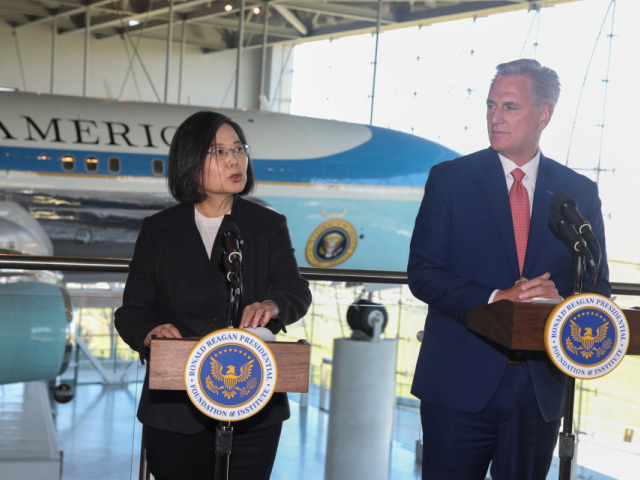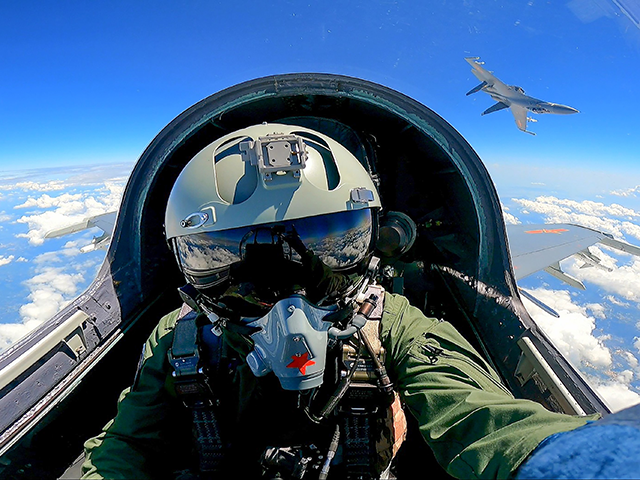China’s state-run Global Times on Monday argued that China’s menacing combat exercises over the weekend — including a simulated rocket attack on Taiwan that would cause massive civilian casualties if conducted for real — would have a “profound impact on the progress of national reunification.”
The Global Times reasoned that China’s belligerent drills, launched in retaliation for Taiwanese President Tsai Ing-wen meeting with U.S. House Speaker Kevin McCarthy (R-CA) while she was in California last week, were actually a positive step toward peaceful “reunification” because the display of strength would convince “Taiwan independence secessionists” to stop daydreaming that the United States could protect them if China decided to invade.

House Speaker Kevin McCarthy (R-CA) right, and Taiwanese President Tsai Ing-wen deliver statements to the press after a Bipartisan Leadership Meeting at the Ronald Reagan Presidential Library in Simi Valley, California, Wednesday, April 5, 2023. (AP Photo/Ringo H.W. Chiu)
The Global Times did not get much solid information about the “Joint Sword” naval and air exercises from China’s own military, so it cited statements by Taiwanese and Japanese officials to gloat over the amount of firepower on display, reportedly including dozens of jet fighter and helicopter sorties from China’s aircraft carrier Shandong.
“Chinese experts” said the Shandong demonstrated its ability to “block Taiwan vessels from fleeing the island” and prevent American or Japanese reinforcements from assisting the Taiwanese.

In this image made from video footage made available Sunday, April 9, 2023, by China’s CCTV, Chinese navy ships take part in a military drill in the Taiwan Strait. China’s military sent several dozen warplanes and 11 warships toward Taiwan in a display of force directed at the self-ruled island, Taiwan’s Defense Ministry said Monday, April 10, after China launched large-scale military drills in retaliation for a meeting between the U.S. House of Representatives speaker and Taiwan’s President. (CCTV via AP, File)
“Under the cover and support by early warning aircraft, fighter jets and electronic warfare aircraft, several batches of H-6K bombers carrying live munitions carried out several waves of mock strikes on key targets on the island of Taiwan,” the Global Times added.
PLA blockade of Taiwan island can cut off energy supply routes, reinforcement routes and escape routes of "Taiwan independence" forces, as well as their hopes for US military reinforcement: experts https://t.co/cl1jZK1mVY
— Global Times (@globaltimesnews) April 10, 2023
Another part of the exercise involved ground-based missile batteries practicing anti-ship launches, including “aircraft carrier killer” ballistic missiles, which could cut off Taiwan’s supply lines as well as threatening U.S. carrier groups.
The Global Times took a moment from its triumphalist account of the Joint Sword exercise to whine about the latest U.S. Navy Freedom of Navigation Operation (FONOP), which once again involved the guided-missile destroyer USS Milius navigating into international waters that have been illegally claimed by China.
The Chinese propagandists complained that the U.S. sent the Milius to “illegally trespass into waters near China’s Meiji Reef in the Nansha Islands in the South China Sea.” The Nansha Islands are better known as the Spratly Islands, and “Meiji Reef” is called Mischief Reef by the United States, or Panganiban Reef by the Philippines.
International courts have decisively rejected China’s claims to the region, so there was nothing “illegal” about the passage of the Milius, but the Global Times gushed over how many Chinese ships and planes monitored the American destroyer and implied force might one day be used against FONOP ships.
The U.S. Navy said the Milius was sent to demonstrate that “no member of the international community should be intimidated or coerced into giving up their rights and freedoms.”
US Navy Conducts Mission in Contested South China Seahttps://t.co/7Cbich25Yw
— Voice of America (@VOANews) April 11, 2023
Pentagon spokesman Chris Meager added that the USS Nimitz carrier group and a Marine Amphibious Ready Group are also conducting “routine operations” in the area.
“We will not be deterred from operating safely and responsibly in the seas and skies of the western Pacific, consistent with international law,” Meager said.
The Chinese People’s Liberation Army (PLA) announced the formal end of its Joint Sword drill on Monday, but then continued with “actual combat training” near Taiwan on Tuesday to “test the organizational and command capabilities of commanders at all levels and the combat effectiveness of weapons and equipment.”
Taiwan President Tsai Ing-wen slammed China's military exercises as ‘irresponsible’, and said they had caused instability in the region https://t.co/DCFecN7una pic.twitter.com/bKwL7W3Cvt
— Reuters (@Reuters) April 11, 2023
The Taiwanese military said it detected nine Chinese ships and 26 aircraft operating near the island on Tuesday. Over 90 Chinese aircraft were involved in the Joint Sword exercises, possibly the largest number of warplanes Beijing has operated near Taiwan to date.
The United States and the Philippines began their own joint military exercise on Tuesday, a program called “Balikatan” (Tagalog for “shoulder-to-shoulder”) that will be among the largest drills ever held by the two nations.
The pre-planned annual "Balikatan" exercises will involve more than 17,600 military personnel and feature the sinking of a boat in Philippine territorial waters https://t.co/uOYS3IcQCi
— Sky News (@SkyNews) April 11, 2023
Balikatan will involve over 17,600 military personnel by the time it is completed, including about a hundred Australians. The program will include live-fire drills with state-of-the-art air, naval, and ground weapons. The U.S. Embassy in Manila said one of the goals is to improve “information and intelligence sharing” between the two forces.
“We are not provoking anybody by simply exercising,” Philippine Col. Michael Logico told the press. “This is actually a form of deterrence. Deterrence is when we are discouraging other parties from invading us.”
Logico said one of the live-fire drills will involve U.S. and Filipino forces working together to sink a target ship in Philippine territorial waters, using both air power and coastal artillery. No such exercise has ever been conducted before.
“We have to fire at a target that is closer to what we would expect in an actual threat, which is an intrusion coming from an adversary by sea. We are demonstrating that we are combat ready,” Logico explained.
Another test scenario will involve U.S. and Filipino units working together to retake a Philippine island that has been captured by enemy forces. The BBC suspected China would be annoyed by both the ship-sinking and island-recapture exercises, since Chinese forces are the only plausible enemy for both scenarios.
The Philippine government recently gave U.S. forces access to four additional military bases. One of them faces Taiwan, and two of the others face South China Sea islands claimed by both China and the Philippines.

COMMENTS
Please let us know if you're having issues with commenting.